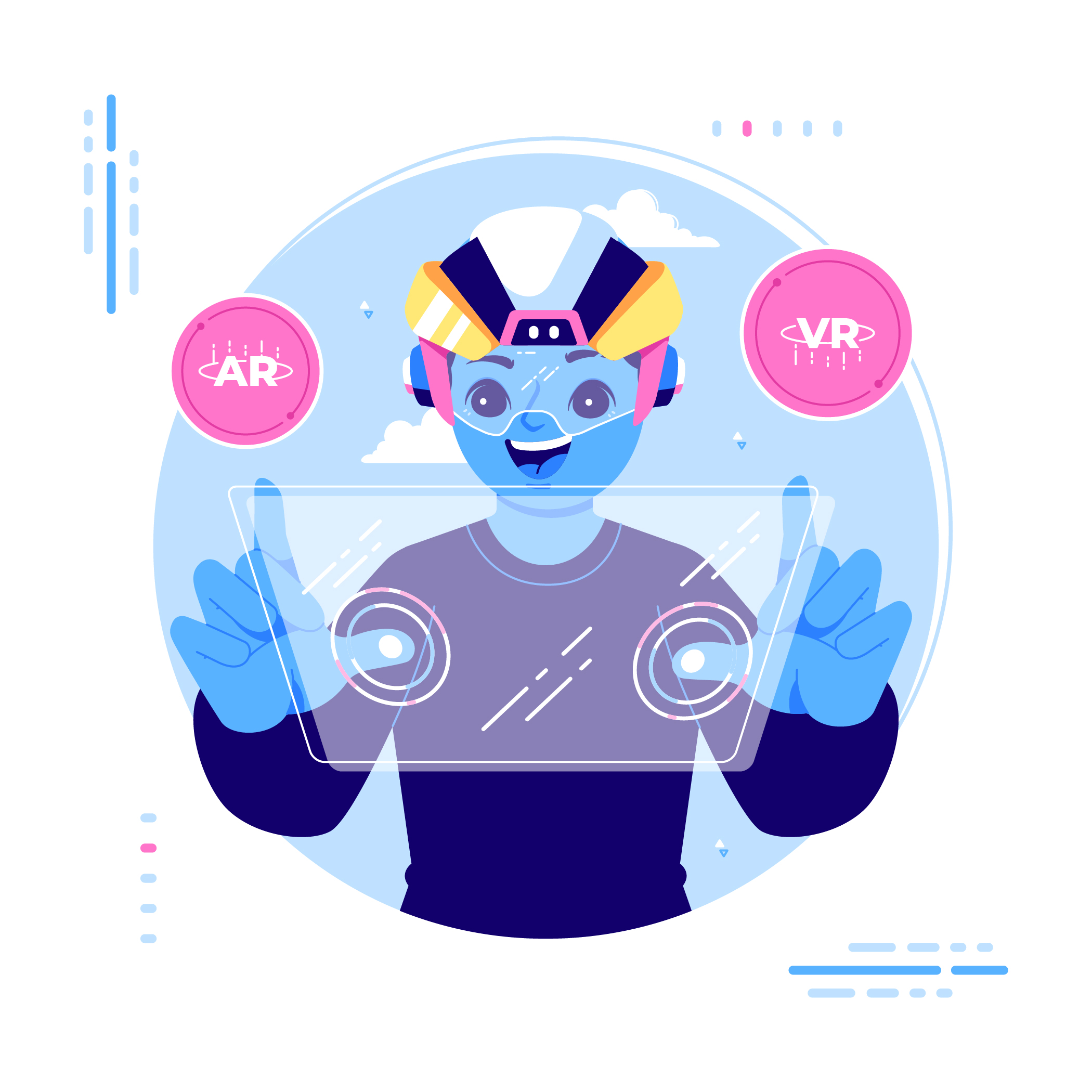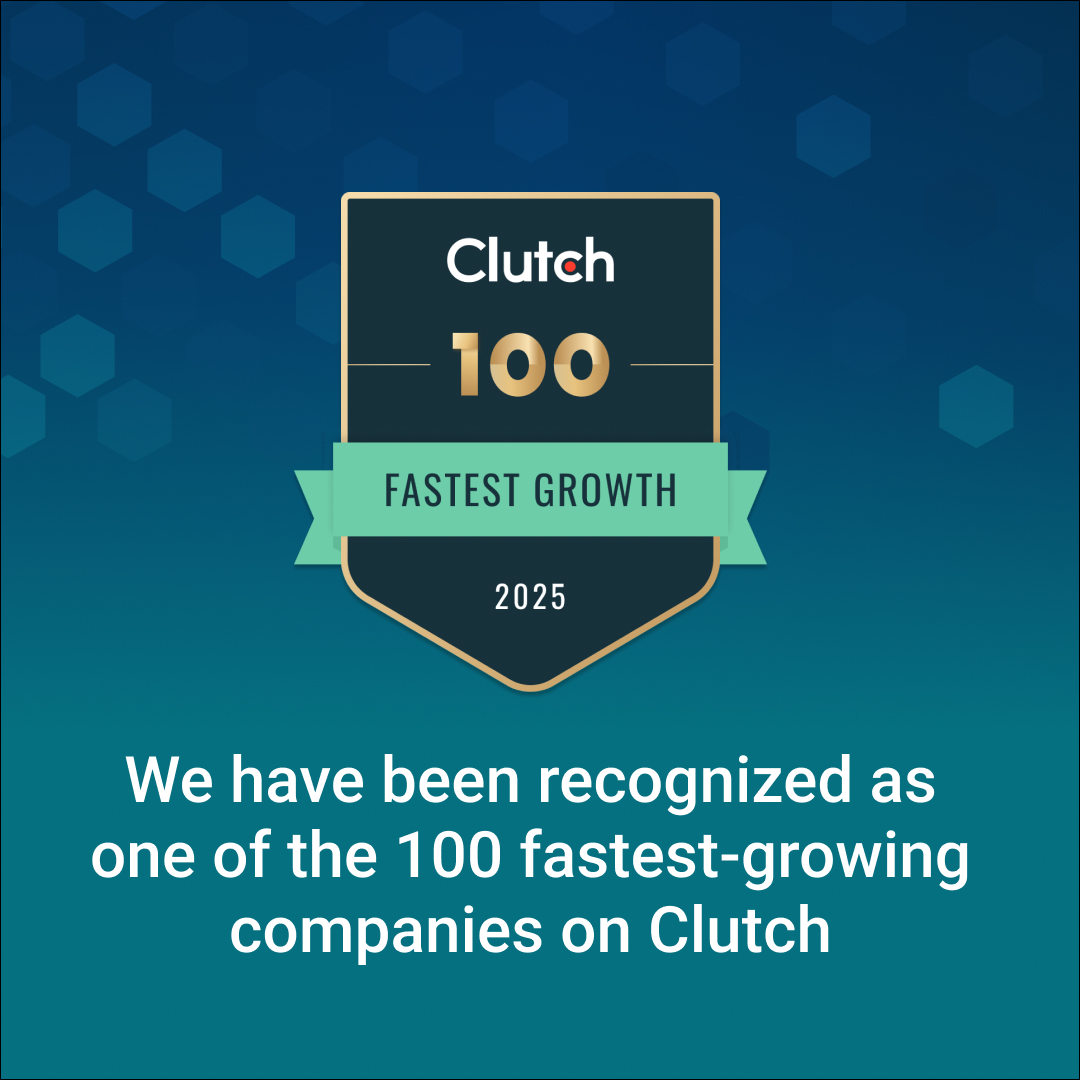Introduction
In today’s rapidly evolving business landscape, Artificial Intelligence (AI) is becoming a game-changer, offering unprecedented opportunities for innovation and growth. However, the path to fully leveraging AI’s potential can be complex and fraught with challenges. One of the key steps businesses must take before diving into large-scale AI implementation is developing an AI Proof of Concept (PoC). In this guide, we’ll explore what an AI PoC is, why it’s crucial for business success, and address some common misconceptions about its value.
1.1 What is an AI Proof of Concept (PoC)?
 An AI Proof of Concept (PoC) is a small-scale, focused experiment or prototype designed to demonstrate the feasibility of an AI solution in solving a specific business problem. It typically involves creating a model or system that addresses a particular issue within a defined scope, allowing businesses to evaluate the effectiveness and potential of AI technologies before committing to full-scale deployment. The goal is to prove that AI can deliver tangible results, such as increased efficiency, reduced costs, or improved decision-making.
An AI Proof of Concept (PoC) is a small-scale, focused experiment or prototype designed to demonstrate the feasibility of an AI solution in solving a specific business problem. It typically involves creating a model or system that addresses a particular issue within a defined scope, allowing businesses to evaluate the effectiveness and potential of AI technologies before committing to full-scale deployment. The goal is to prove that AI can deliver tangible results, such as increased efficiency, reduced costs, or improved decision-making.
A PoC serves as an early indicator of the AI solution’s practicality, and it often includes testing key parameters, data models, and performance metrics. Once the PoC is complete, the results can guide decisions regarding the future scale-up or modification of the AI system.
1.2 Why is AI PoC Essential for Business Success?
Implementing AI is a significant investment for any business, and its success isn’t guaranteed. Therefore, AI PoC becomes essential in mitigating risks and ensuring that businesses make informed decisions about adopting AI. The benefits of conducting an AI PoC are numerous:
- Risk Reduction: AI implementations can be costly and time-consuming. A PoC allows businesses to test and refine their AI approach before committing to a large-scale project, thus reducing the risk of failure.
- Resource Efficiency: A PoC helps identify the most effective AI models and technologies for a given problem, enabling businesses to allocate resources more effectively.
- Stakeholder Buy-In: Presenting a successful PoC can garner support from stakeholders, investors, or upper management, who may be hesitant to invest in AI without evidence of its potential value.
By conducting an AI PoC, businesses can validate assumptions, test AI’s compatibility with existing systems, and gain insights that guide further development or adjustments. This ensures that resources are spent on solutions that will truly add value.
1.3 Common Misconceptions About AI PoC
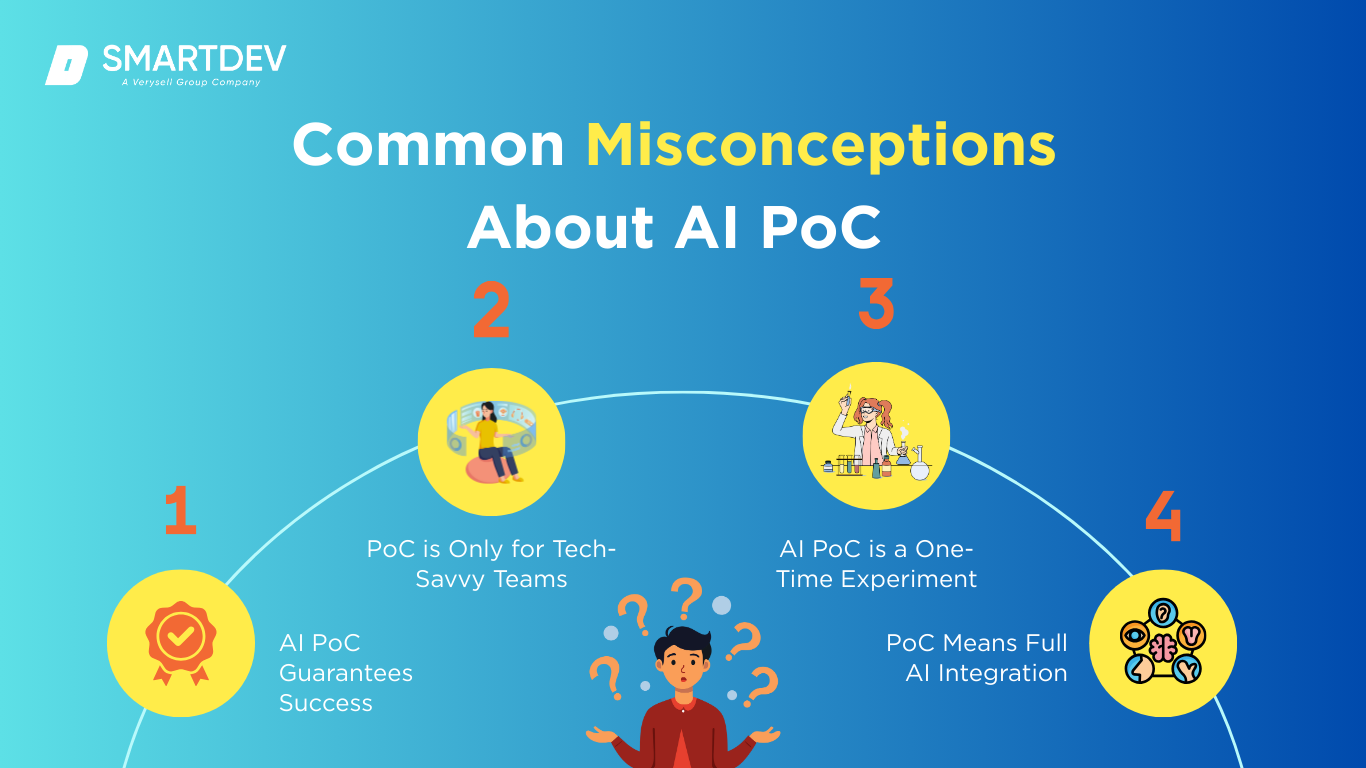 While AI PoC is a critical step in AI adoption, there are several misconceptions that can hinder its successful implementation. It’s important to be aware of these common misunderstandings to avoid pitfalls.
While AI PoC is a critical step in AI adoption, there are several misconceptions that can hinder its successful implementation. It’s important to be aware of these common misunderstandings to avoid pitfalls.
- AI PoC Guarantees Success: A PoC is an initial test, not a guaranteed predictor of success. Just because an AI solution works on a small scale doesn’t mean it will seamlessly transition to a larger system.
- PoC is Only for Tech-Savvy Teams: Some believe that AI PoCs is only useful for highly technical teams or organizations with advanced data science expertise. However, a well-executed PoC can be beneficial to businesses of all sizes and industries, even those without extensive in-house AI knowledge.
- AI PoC is a One-Time Experiment: Another misconception is that an AI PoC is a one-off project. In reality, PoCs are iterative, and insights gained from the first iteration can inform future improvements, adjustments, or even completely new AI initiatives.
- PoC Means Full AI Integration: Some businesses may misunderstand the PoC as a precursor to immediate full-scale AI implementation. In fact, a PoC is just the beginning of a process that may involve further refinement, scaling, or even pivoting to a different AI solution.
By addressing these misconceptions and properly understanding the role of a PoC, businesses can avoid missteps and ensure a more successful AI implementation journey.
-
Understanding AI PoC in Detail
A deeper understanding of AI Proof of Concept (PoC) is essential for businesses to successfully implement AI solutions. In this section, we will examine the purpose of an AI PoC, distinguish between an AI PoC, prototype, and pilot, and explore the key benefits of running an AI PoC.
2.1 The Purpose of an AI PoC
The primary purpose of an AI PoC is to validate the viability of an AI solution in solving a specific problem within a business context. Rather than committing resources to a full-scale AI project, a PoC allows organizations to test a model or technology on a smaller scale to gauge its potential impact. This includes evaluating the technical feasibility, the accuracy of algorithms, and the solution’s ability to integrate with existing systems. Essentially, an AI PoC helps businesses assess whether an AI-driven approach can achieve the desired outcomes without investing in extensive development and deployment.
In addition to evaluating the solution’s potential, a PoC serves to uncover challenges and areas for improvement. By iterating on the PoC, companies can fine-tune AI models and adjust their strategies before scaling. It can also help align AI efforts with overall business goals and provide valuable data to make more informed decisions.
2.2 AI PoC vs. AI Prototype vs. AI Pilot – Key Differences
While the terms “PoC,” “prototype,” and “pilot” are often used interchangeably, they refer to distinct phases in the AI development process. Understanding these differences is crucial for businesses to apply the right approach at each stage.
| Aspect | AI Proof of Concept (PoC) | AI Prototype | AI Pilot |
| Definition | A small-scale, short-term test to validate the feasibility of an AI solution for a specific problem. | A more developed version of the AI solution showcasing how it might function when fully deployed. | A larger-scale test involving real-world deployment of the AI solution in a specific department or group. |
| Focus | Feasibility testing and proof of the AI model’s potential. | Demonstrating a working version of the AI solution with improved functionality and user feedback. | Real-world application and performance testing of the AI solution under regular business conditions. |
| Scope | Limited scope, focused on proving the technology can solve the problem. | Broader scope than a PoC, but still in the experimental phase. | Full-scale test in a specific environment or business area. |
| Timeframe | Short-term (weeks to a few months). | Mid-term (months). | Longer-term (several months or more). |
| Objective | To determine whether the AI solution is worth pursuing further. | To demonstrate a near-final version of the AI solution. | To assess the solution’s functionality and effectiveness at scale. |
| Outcome | Decision on whether to move forward with further development or abandon the idea. | Gathering user feedback and refining the solution for full-scale implementation. | Collecting data to make final decisions on full deployment. |
2.3 Key Benefits of Running an AI PoC
Running an AI PoC provides a wealth of benefits for businesses that want to explore AI’s potential without diving straight into large-scale projects. The key benefits include:
- Risk Mitigation: By testing AI on a small scale, businesses can identify potential risks and challenges early on, preventing larger failures later. It allows businesses to address issues such as data compatibility, system integration, and model performance before making a significant investment.
- Cost Efficiency: A PoC enables businesses to assess whether the AI solution is worth the investment, preventing the unnecessary allocation of resources to projects that may not be viable. It helps save time and money by confirming whether the AI model can deliver the expected outcomes on a smaller scale before scaling it up.
- Informed Decision-Making: With a clear understanding of the AI solution’s feasibility, businesses are better positioned to make informed decisions about future investments. They can decide whether to pursue further development, make adjustments to the model, or pivot to another solution entirely.
- Enhanced Collaboration: During the PoC phase, cross-functional teams—such as data scientists, business analysts, and operations experts—can collaborate closely, ensuring the AI solution aligns with organizational goals. This also helps build internal support for AI adoption across various departments.
Ultimately, an AI PoC acts as a proving ground for AI technologies, allowing businesses to explore the potential benefits and drawbacks before making more significant commitments. By running a PoC, organizations can mitigate risk, save resources, and gain valuable insights that guide the broader AI implementation process.
-
The AI PoC Framework: A Step-by-Step Guide
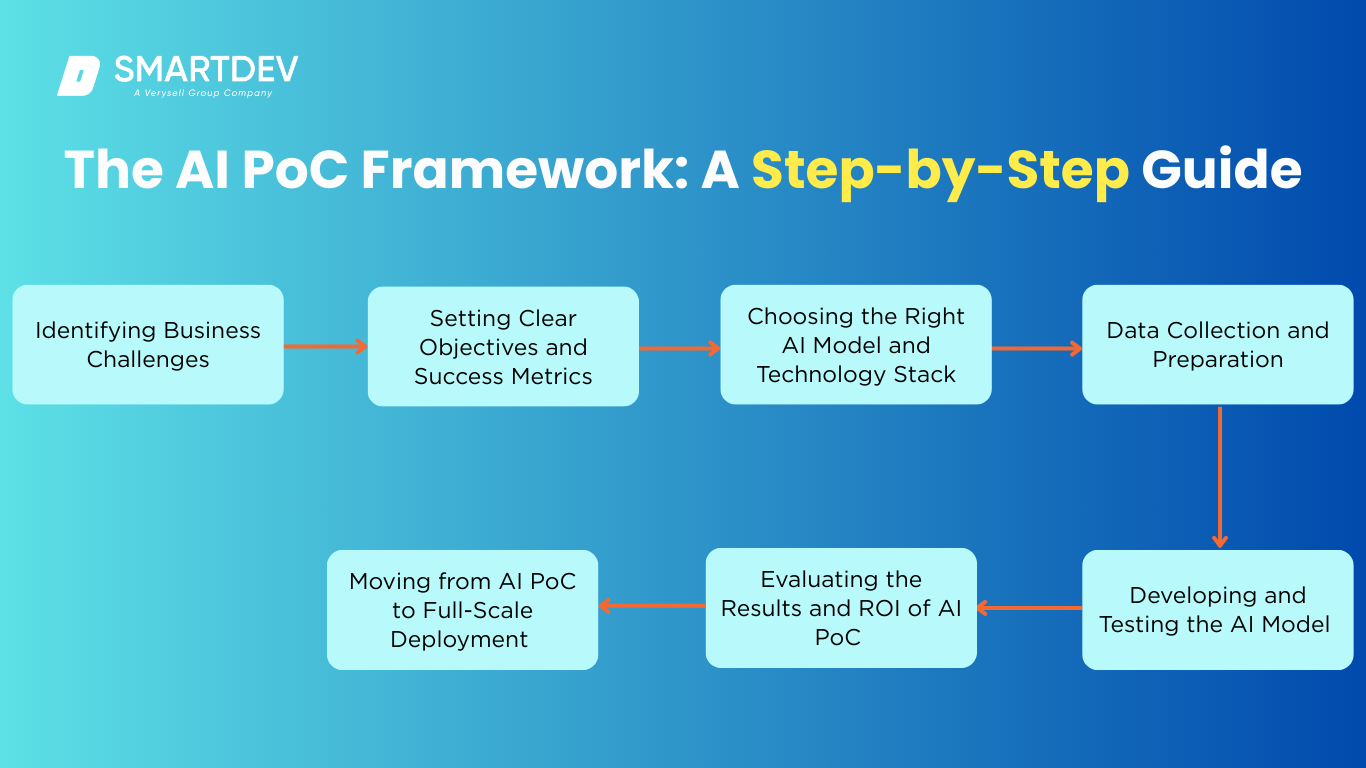 The AI Proof of Concept (PoC) framework is an indispensable tool for businesses seeking to implement AI solutions in a structured and effective manner. The process begins with the identification of specific business challenges or pain points that AI can address, ensuring that the chosen solution aligns with the company’s strategic goals. For instance, in industries such as healthcare, AI has the potential to improve the accuracy of tasks like diagnostic imaging, significantly enhancing the precision of medical assessments and patient outcomes (futurumgroup.com). By pinpointing the problem areas, businesses can better understand how AI can drive efficiency and productivity.
The AI Proof of Concept (PoC) framework is an indispensable tool for businesses seeking to implement AI solutions in a structured and effective manner. The process begins with the identification of specific business challenges or pain points that AI can address, ensuring that the chosen solution aligns with the company’s strategic goals. For instance, in industries such as healthcare, AI has the potential to improve the accuracy of tasks like diagnostic imaging, significantly enhancing the precision of medical assessments and patient outcomes (futurumgroup.com). By pinpointing the problem areas, businesses can better understand how AI can drive efficiency and productivity.
Once the challenges have been identified, the next step involves setting clear, actionable objectives and defining success metrics. These metrics provide a framework for assessing the performance of the AI solution, allowing businesses to measure the effectiveness of the implementation. Success metrics might include factors such as accuracy rates, speed improvements, cost reduction, or user satisfaction, depending on the nature of the business and the specific goals.
The subsequent phase focuses on selecting the appropriate AI model and technology stack. This decision is critical, as the right tools and technologies can dramatically influence the performance and scalability of the AI solution. The selection process typically involves evaluating various machine learning models, algorithms, and data processing techniques to determine the most suitable approach for the specific business use case.
Following the technology selection, businesses must then focus on gathering and preparing high-quality data. Data is the backbone of any AI system, and its accuracy, volume, and relevance are crucial for the model’s success. Data preparation involves cleaning, normalizing, and transforming raw data into a format that can be fed into the AI model for training and testing. This step ensures that the AI system will operate on a solid foundation, improving its performance and the reliability of its outcomes.
Once the data is ready, the AI model is developed, trained, and rigorously tested. During this phase, businesses evaluate the model’s performance against the predefined success metrics. Testing allows for adjustments and refinements to the model, ensuring that it can handle real-world scenarios and deliver the expected results. Performance evaluation may involve cross-validation, error analysis, and testing with various datasets to ensure the model’s robustness and accuracy.
After evaluating the model’s results, businesses calculate the return on investment (ROI) to determine the financial viability of scaling the AI solution. A comprehensive ROI analysis considers factors such as the initial investment, ongoing operational costs, and the expected benefits, including efficiency gains, cost savings, and revenue growth. This analysis provides critical insights into whether the AI solution is a worthwhile investment.
Finally, once the PoC has been successfully validated and the ROI has been confirmed, businesses can transition from the PoC phase to full-scale deployment. This stage involves integrating the AI solution into daily operations and workflows, ensuring that it adds value across the organization. The goal is to maximize the impact of the AI solution, driving sustained improvements in business performance and creating a competitive advantage in the marketplace.
-
AI PoC Examples Across Industries
 4.1 AI PoC in Healthcare
4.1 AI PoC in Healthcare
In the healthcare sector, AI PoCs have demonstrated significant improvements in diagnostic accuracy and drug development processes. For instance, a hospital collaborated on an AI PoC aimed at enhancing diagnostic precision through advanced image analysis. The AI system was trained to examine medical images such as X-rays and MRIs, identifying early indicators of diseases like cancer. This initiative substantially reduced diagnostic timelines and bolstered treatment planning, ultimately leading to improved patient outcomes (Onix, 2024).
4.2 AI PoC in Finance
Financial institutions are leveraging AI PoCs to bolster security and optimize trading strategies. For example, Scotiabank utilized Google’s Gemini and Vertex AI to create a personalized and predictive banking experience. This AI-driven approach powers their award-winning chatbot, enhancing digital client interactions and exemplifying AI’s potential to enrich customer experiences in the financial sector (Google Cloud, 2024).
4.3 AI PoC in Retail
Retailers are adopting AI PoCs to gain deeper customer insights and forecast demand more accurately. A notable example is a major retailer that collaborated on an AI PoC to optimize inventory management. The AI analyzed extensive purchasing data to predict demand trends, enabling more efficient stock level management. This led to a reduction in both overstock and stockouts, improving inventory turnover and boosting sales (Onix, 2024).
4.4 AI PoC in Manufacturing
Manufacturing firms are implementing AI PoCs to enhance operational efficiency through predictive maintenance and automation. For instance, a manufacturing company partnered with an AI PoC to implement predictive maintenance for their machinery. The AI system continuously monitored equipment data, forecasting potential failures before they occurred. This proactive approach minimized downtime, reduced maintenance costs, and increased overall operational efficiency (RTS, 2024).
4.5 AI PoC in Marketing
In marketing, AI PoCs is utilized to deliver personalized customer experiences and automate interactions. An example is a telecommunications company that developed an AI PoC for chatbots capable of handling common customer inquiries. This solution improved response times and allowed human agents to focus on more complex issues, enhancing overall customer satisfaction.
4.6 AI PoC in Legal & Compliance
The legal sector benefits from AI PoCs through enhanced document processing and risk management. AI applications in this field can automate the analysis of legal documents, extracting key information and identifying potential risks. This automation streamlines workflows, reduces human error, and ensures compliance with regulatory standards.
These examples illustrate the diverse applications of AI PoCs across various industries, highlighting AI’s potential to drive innovation, efficiency, and improved outcomes in multiple domains.
-
Best Practices for a Successful AI PoC
5.1 How to Select the Right AI Vendor or Build In-House
When deciding between selecting an AI vendor or building a solution in-house, businesses must carefully evaluate their resources, expertise, and long-term goals. Opting for an AI vendor can be advantageous if the organization lacks the technical expertise or resources for in-house development. The right vendor should have industry-specific experience, technological proficiency, and a robust support infrastructure. They should also ensure compliance with relevant regulations and data security standards. On the other hand, building an AI solution in-house offers more control and the ability to customize the solution to the organization’s specific needs. However, this approach requires significant investment in skilled personnel and development time. Companies should assess whether they have the internal capabilities to maintain and scale the system effectively in the future.
5.2 How to Minimize Bias in AI PoC Data
Minimizing bias in AI PoC data is essential to ensure the fairness and accuracy of AI systems. Bias can emerge from various sources, including unbalanced datasets or skewed data collection methods. To minimize bias, businesses should ensure that their datasets are diverse and representative of all relevant demographics and scenarios. This requires actively seeking out underrepresented groups or data points. Additionally, regular data auditing is necessary to identify and address any imbalances in the dataset. Implementing algorithms with transparency, where the decision-making process can be interpreted, also helps mitigate bias by allowing developers to understand and refine the model’s behavior. Ongoing monitoring and updates to the AI model are essential to catch and correct emerging biases as the system continues to learn and interact with new data.
5.3 How to Ensure Scalability and Feasibility in AI PoC
For an AI PoC to transition into full-scale deployment successfully, it must be designed with scalability in mind. Companies should focus on creating a modular architecture that allows components of the AI system to be scaled independently as needed. During the PoC phase, businesses should test the performance of the AI model under different conditions, simulating increased data volumes and operational loads to assess its robustness. Additionally, it is important to ensure that the AI system integrates seamlessly with the company’s existing infrastructure and workflows. Scalability is not only about handling more data but also ensuring that the AI system can be deployed across different departments or geographies without significant modification. By assessing and planning for scalability and feasibility upfront, companies can ensure a smoother transition from PoC to production.
5.4 Avoiding Common Pitfalls in AI PoC
There are several common pitfalls businesses should avoid when implementing an AI PoC. First, unclear objectives can derail the project. It is crucial to define specific, measurable goals from the outset to guide development and evaluation. Another common issue is insufficient data quality, which can lead to poor model performance. To avoid this, businesses must invest in high-quality, relevant datasets and continuously clean and refine them throughout the PoC. Stakeholder engagement is also key; failing to involve key stakeholders early on can result in misalignment with business goals. Moreover, neglecting change management can hinder the successful adoption of AI solutions, as employees may struggle to adapt to new systems. Finally, overlooking ethical considerations such as fairness, transparency, and accountability in AI development can damage the organization’s reputation and erode trust. By proactively addressing these pitfalls, businesses can significantly increase the likelihood of a successful AI PoC and its eventual full-scale implementation.
-
Challenges & Risks in AI PoC Implementation
 6.1 Lack of High-Quality Data for AI PoC
6.1 Lack of High-Quality Data for AI PoC
One of the most significant challenges in implementing an AI PoC is the lack of high-quality data. AI models rely heavily on data for training, and if the data is incomplete, inaccurate, or unrepresentative, the model’s performance can be compromised. In many industries, businesses may struggle to access the necessary data or may have data that is siloed, inconsistent, or difficult to integrate. Additionally, data privacy and security concerns can limit the ability to use certain datasets, particularly in sensitive industries like healthcare and finance. To overcome this challenge, businesses must ensure they have access to clean, high-quality data or invest in data collection and cleaning processes. It may also be necessary to partner with external providers or leverage synthetic data to fill gaps, especially if the required data is not readily available or ethically accessible.
6.2 Overestimating AI Capabilities in Early Stages
Another risk in AI PoC implementation is overestimating the capabilities of AI, especially during the early stages of development. AI technologies, while powerful, are not always capable of solving complex problems immediately. In the PoC phase, businesses may expect AI to perform flawlessly, but the technology often requires extensive testing, fine-tuning, and iteration to reach optimal performance. Misleading expectations can lead to disappointment or even failure if the model does not deliver immediate results. To mitigate this risk, it is crucial to have realistic expectations about the scope of what AI can achieve in the PoC phase and to allow room for improvement through continuous testing and refinement. Organizations should also ensure that they focus on achievable objectives and avoid setting overly ambitious goals that may not be feasible within the constraints of the PoC.
6.3 High Costs and Budget Constraints in AI PoC
The financial aspect of AI PoC implementation presents a significant challenge for many businesses. Developing, testing, and deploying AI solutions can be resource-intensive, particularly in the early stages, when companies must invest in skilled personnel, data acquisition, and technology infrastructure. High costs can also arise from the need for specialized hardware, such as GPUs for training AI models, or from engaging external vendors and consultants. Additionally, AI PoC projects often experience unforeseen delays and cost overruns, which can further strain budgets. To address these challenges, businesses should plan carefully and allocate sufficient resources for the PoC phase. It is also helpful to establish clear financial goals and ROI metrics from the outset, allowing for a more structured approach to budget management. Exploring partnerships or cloud-based solutions can help reduce upfront costs by leveraging external infrastructure.
6.4 Ethical and Regulatory Concerns in AI PoC
Ethical and regulatory concerns are paramount when implementing AI PoCs, particularly as AI systems have the potential to impact individuals’ lives and data. Issues such as bias in data, lack of transparency in decision-making processes, and potential invasions of privacy can raise significant concerns. Furthermore, regulatory bodies are increasingly focusing on AI and data privacy laws, such as the GDPR in Europe, which impose strict rules on data collection, usage, and consent. Businesses must ensure their AI PoC complies with applicable regulations and is ethically sound. This requires clear protocols for data collection, model transparency, and auditing of AI decision-making. Addressing these ethical and regulatory issues early in the PoC phase is crucial to avoid legal consequences, build trust with users, and ensure the responsible use of AI technology. Regular audits and engaging with external ethics boards or regulatory bodies can also help ensure that the project remains compliant and aligned with industry standards.
-
Tools and Resources for AI PoC
 7.1 Top AI Platforms for PoC Development
7.1 Top AI Platforms for PoC Development
When developing an AI PoC, leveraging robust AI platforms is essential for streamlining the process and ensuring successful deployment. Some of the most popular platforms include TensorFlow, Azure AI, and Google AutoML. TensorFlow is an open-source platform widely used for machine learning and deep learning projects, providing an extensive set of tools and libraries for AI model development, training, and deployment. Azure AI, from Microsoft, offers a range of AI services, including pre-built models, machine learning tools, and cognitive APIs, making it a versatile choice for companies that need both development capabilities and easy integration with other Azure services. Google AutoML, on the other hand, is designed to simplify the AI model building process by offering automated machine learning services. It allows businesses to build custom AI models with minimal coding, making it an ideal choice for organizations without extensive machine learning expertise. These platforms provide powerful resources to accelerate the AI PoC development process, helping businesses focus on their specific goals without reinventing the wheel.
7.2 No-Code AI Platforms for Quick AI PoC Testing
For businesses looking to rapidly prototype AI solutions without the need for deep technical knowledge, no-code AI platforms provide a user-friendly alternative for quick AI PoC testing. Platforms like Lobe, DataRobot, and Teachable Machine allow users to create machine learning models with little to no coding experience. Lobe, for example, offers a simple drag-and-drop interface to build custom models, making it accessible for non-technical users. DataRobot provides automated machine learning tools that allow users to upload their data, choose the relevant models, and generate results without writing any code. Teachable Machine, developed by Google, offers an easy way to train models on custom datasets directly within a web browser, enabling users to experiment with AI applications quickly. These no-code platforms significantly reduce the time to test and deploy AI PoCs, democratizing access to AI technology for businesses of all sizes and technical capabilities.
7.3 AI PoC Case Studies & Whitepapers
Learning from real-world examples is crucial when developing AI PoCs, and case studies and whitepapers provide invaluable insights into how organizations have successfully implemented AI technologies. Companies can explore case studies from various industries to understand how AI solutions have been applied to specific business problems. Whitepapers, often published by leading technology companies or research institutions, provide detailed technical analyses, best practices, and lessons learned from AI PoC projects. Resources such as Google Cloud’s AI & Machine Learning Case Studies and IBM’s AI Research Whitepapers offer concrete examples of AI implementations across industries like healthcare, finance, retail, and more. These resources help businesses design and implement their own AI PoCs more effectively, learning from the challenges and successes of others.
7.4 AI PoC Communities and Open-Source Repositories
Engaging with AI communities and exploring open-source repositories can provide valuable support and resources throughout the PoC development process. Communities like AI Stack Exchange, Kaggle, and Reddit’s Machine Learning Subreddit offer forums for discussing ideas, asking questions, and troubleshooting problems with fellow AI practitioners. These communities are essential for staying up to date with the latest trends and learning from the experiences of others. Additionally, open-source repositories such as GitHub and GitLab are rich resources for AI-related code and projects. Many developers and organizations share their AI models, code snippets, and tutorials on these platforms, offering a wealth of knowledge that can be leveraged to accelerate PoC development. Open-source projects like scikit-learn, PyTorch, and Hugging Face provide pre-built tools and libraries that can be used to quickly prototype and test AI models, reducing the need to build from scratch. Engaging with these communities and utilizing open-source resources can significantly enhance the efficiency and quality of AI PoC development.
-
AI PoC Case Studies from Real-World Success Stories
A notable example of a successful AI Proof of Concept (PoC) is the collaboration between ScienceSoft and a client aiming to automate network penetration testing. The objective was to develop an AI model capable of generating and simulating attack vectors based on Common Vulnerabilities and Exposures (CVEs). ScienceSoft’s team initiated a PoC to validate the feasibility of this approach.
Approach:
- AI Model Development: Data scientists at ScienceSoft built a custom large language model (LLM) using Python and the PyTorch library. The model was trained on extensive datasets, including both free and paid libraries of CVEs, exploits, payloads, and remediation measures.
- Integration: The AI model was seamlessly integrated into the client’s existing penetration testing tool. This integration enabled the tool to identify network infrastructure components and CVEs, facilitating the generation of optimal attack vectors.
- Iterative Testing: Through multiple rounds of attack simulations and model refinements, the AI system’s accuracy and effectiveness were enhanced, ensuring comprehensive coverage of potential network vulnerabilities.
Outcome:
The PoC demonstrated that the AI-enhanced penetration testing tool could autonomously generate and simulate attack vectors, effectively identifying network vulnerabilities. This automation not only streamlined the testing process but also provided a scalable solution for continuous security assessments. The success of the PoC paved the way for developing a full-scale AI model, significantly enhancing the client’s cybersecurity measures
-
Future of AI PoC: Trends & Innovations
9.1 The Role of Generative AI in AI PoC
Generative AI is increasingly playing a pivotal role in AI Proof of Concept (PoC) development across various industries. This subset of AI, which includes models like GPT (Generative Pretrained Transformers) and GANs (Generative Adversarial Networks), enables the creation of new data or content based on learned patterns. In AI PoCs, generative models are used to enhance innovation by automating content creation, such as generating synthetic data for training purposes, producing design prototypes, or even automating text generation for chatbots and customer service applications. This allows businesses to explore new capabilities quickly and with less manual intervention, accelerating the process of testing and iterating AI solutions. As generative AI continues to evolve, it is expected to streamline PoC development, provide cost-effective solutions, and contribute to more advanced, creative applications in fields such as marketing, healthcare, and entertainment.
9.2 AI PoC and the Evolution of Edge AI
Edge AI refers to the deployment of artificial intelligence algorithms on local devices rather than relying on centralized cloud-based servers. This trend has significant implications for AI PoC development. In the past, AI models required high computational power and data storage in the cloud, leading to latency issues, security concerns, and increased operational costs. With the rise of edge computing, AI PoCs are now being developed with the ability to process data directly on devices such as smartphones, industrial equipment, or IoT devices, offering faster decision-making, reduced latency, and better data privacy. This evolution allows companies to test AI solutions that can operate in real-time, on-site, without the need for constant internet connectivity. As edge AI continues to mature, it will unlock new possibilities for industries like manufacturing, logistics, and healthcare, where rapid, local decision-making is essential.
9.3 AI PoC in Quantum Computing – What’s Next?
Quantum computing holds immense promise for revolutionizing AI by solving complex problems at speeds far exceeding traditional computing. Although still in its early stages, quantum computing is expected to play a transformative role in AI PoC development. With its ability to perform calculations that are infeasible for classical computers, quantum computing could drastically improve AI models in areas like optimization, drug discovery, and cryptography. For example, AI PoCs utilizing quantum algorithms could be employed to model complex systems with far greater accuracy or to run simulations that would take traditional computers years to process. However, the integration of quantum computing with AI remains a challenge due to the technical limitations of current quantum hardware. As quantum computing technology advances, AI PoCs will likely benefit from breakthroughs in quantum algorithms, potentially enabling more powerful and efficient AI systems across various sectors.
-
Conclusion & Next Steps
10.1 How to Get Started with Your First AI PoC
Getting started with your first AI Proof of Concept (PoC) requires a structured approach. Begin by clearly defining the problem or business challenge you aim to solve with AI. Identify the key objectives and success metrics to measure progress and effectiveness. It is crucial to involve relevant stakeholders early in the process, ensuring alignment with business goals. Once the problem is well-defined, you can proceed with selecting the right AI model or technology stack and gathering the necessary data for training. During this phase, focus on small, manageable projects to demonstrate the AI model’s potential before scaling. Collaborate with AI experts, vendors, or use no-code platforms if you lack internal AI expertise. The first PoC should be seen as a learning experience, providing insights into the feasibility and scalability of AI solutions within your business context.
10.2 Checklist for Running a Successful AI PoC
To ensure the success of your AI PoC, follow this checklist:
- Define Clear Objectives: Identify the specific problem you are solving with AI and set measurable goals.
- Engage Stakeholders: Involve key business leaders, IT teams, and data scientists from the start.
- Data Collection & Preparation: Gather high-quality data that is relevant and comprehensive for your AI model.
- Select the Right AI Model: Choose an appropriate AI model and technology stack based on your objectives.
- Build & Test the Model: Develop the AI model, train it with the data, and evaluate its performance against predefined success metrics.
- Evaluate ROI: Calculate the return on investment (ROI) by assessing improvements in efficiency, cost reduction, or other relevant KPIs.
- Plan for Scaling: Consider how the AI model can be scaled for broader deployment across the organization.
- Monitor & Iterate: Continuously monitor the model’s performance and refine it as needed to improve its results.
By following this checklist, businesses can systematically address the key components of a successful AI PoC and avoid common pitfalls.
10.3 Final Thoughts on the AI PoC Journey
Embarking on the AI PoC journey is a significant step toward transforming your business with cutting-edge technology. While the process may seem daunting at first, it offers substantial opportunities for innovation, cost savings, and efficiency improvements. By taking small, deliberate steps, defining clear objectives, and focusing on iterative learning, you can effectively test and refine AI solutions to meet your business needs. Now is the time to act – start planning your AI PoC, gather your data, and partner with the right experts or platforms to turn your AI ambitions into reality. Embrace the journey and take the first step towards building smarter, data-driven solutions that will propel your business forward in an increasingly competitive landscape.
References:
-
Futurum Group. (n.d.). AI on CPUs: A PoC for Healthcare. Retrieved from https://futurumgroup.com/research-reports/ai-on-cpus-a-poc-for-healthcare/
-
Onix Systems. (n.d.). Ultimate Guide to AI Proof of Concept. Retrieved from https://onix-systems.com/blog/ultimate-guide-ai-proof-of-concept
-
Google Cloud. (n.d.). 101 Real-World Generative AI Use Cases from Industry Leaders. Retrieved from https://cloud.google.com/transform/101-real-world-generative-ai-use-cases-from-industry-leaders
-
RTS Labs. (n.d.). AI Proof of Concept Development. Retrieved from https://rtslabs.com/ai-proof-of-concept-development
-
ScienceSoft. (n.d.). AI Model PoC for Penetration Testing Automation. Retrieved from https://www.scnsoft.com/case-studies/ai-model-poc-for-pentesting-automation

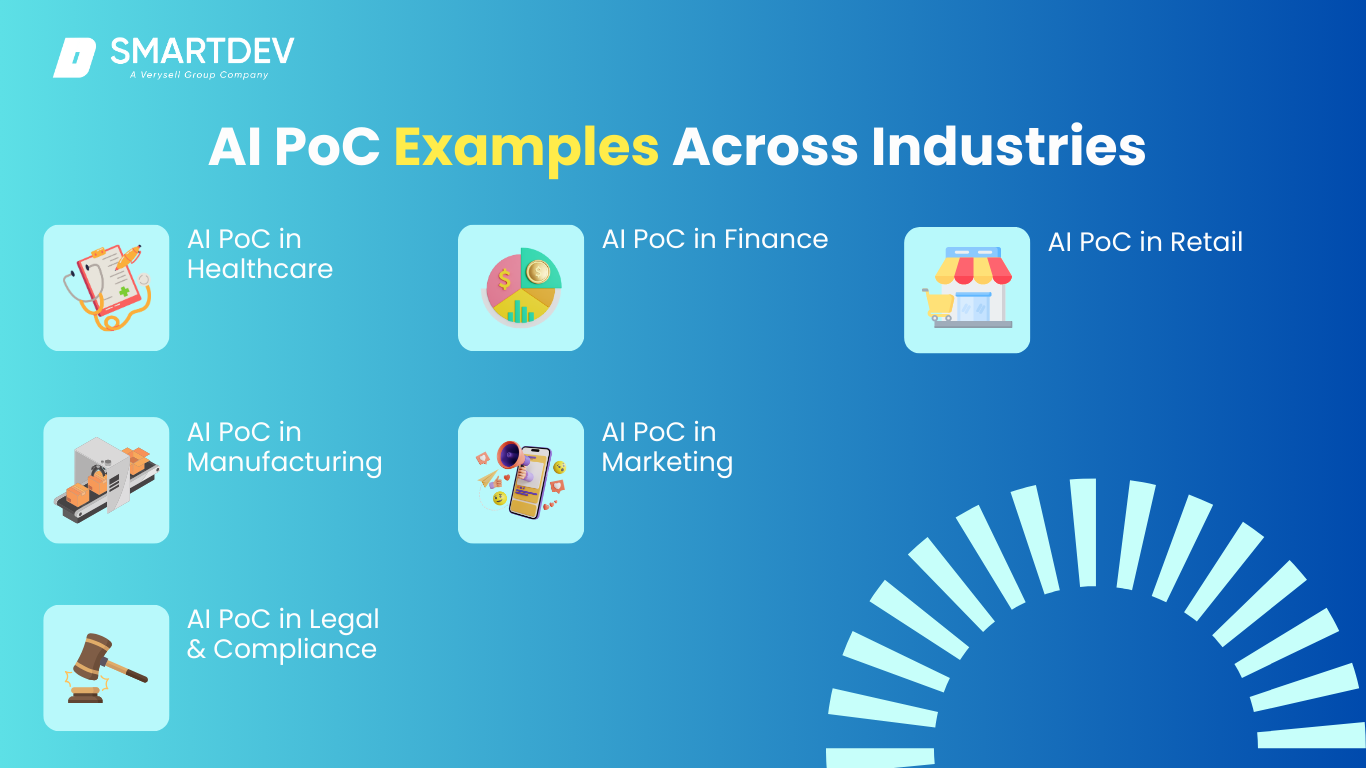 4.1 AI PoC in Healthcare
4.1 AI PoC in Healthcare 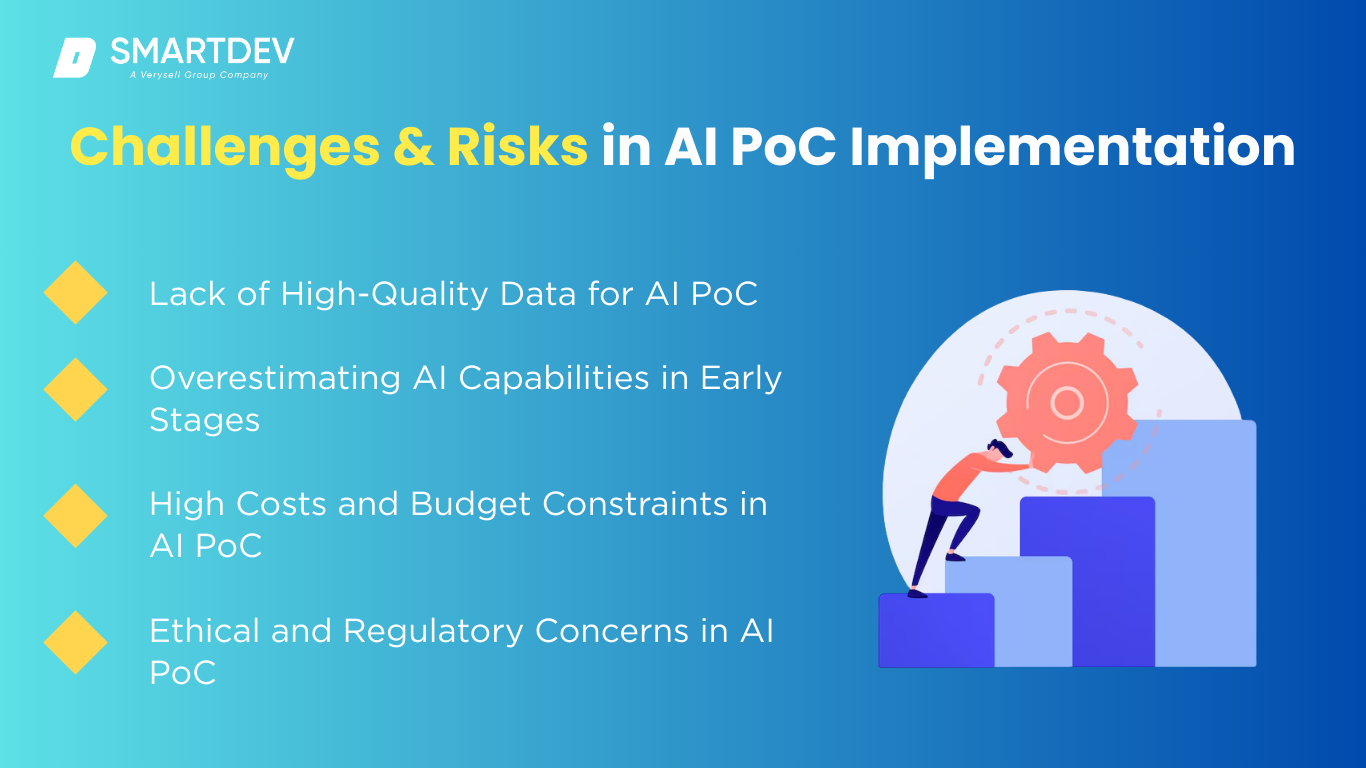 6.1 Lack of High-Quality Data for AI PoC
6.1 Lack of High-Quality Data for AI PoC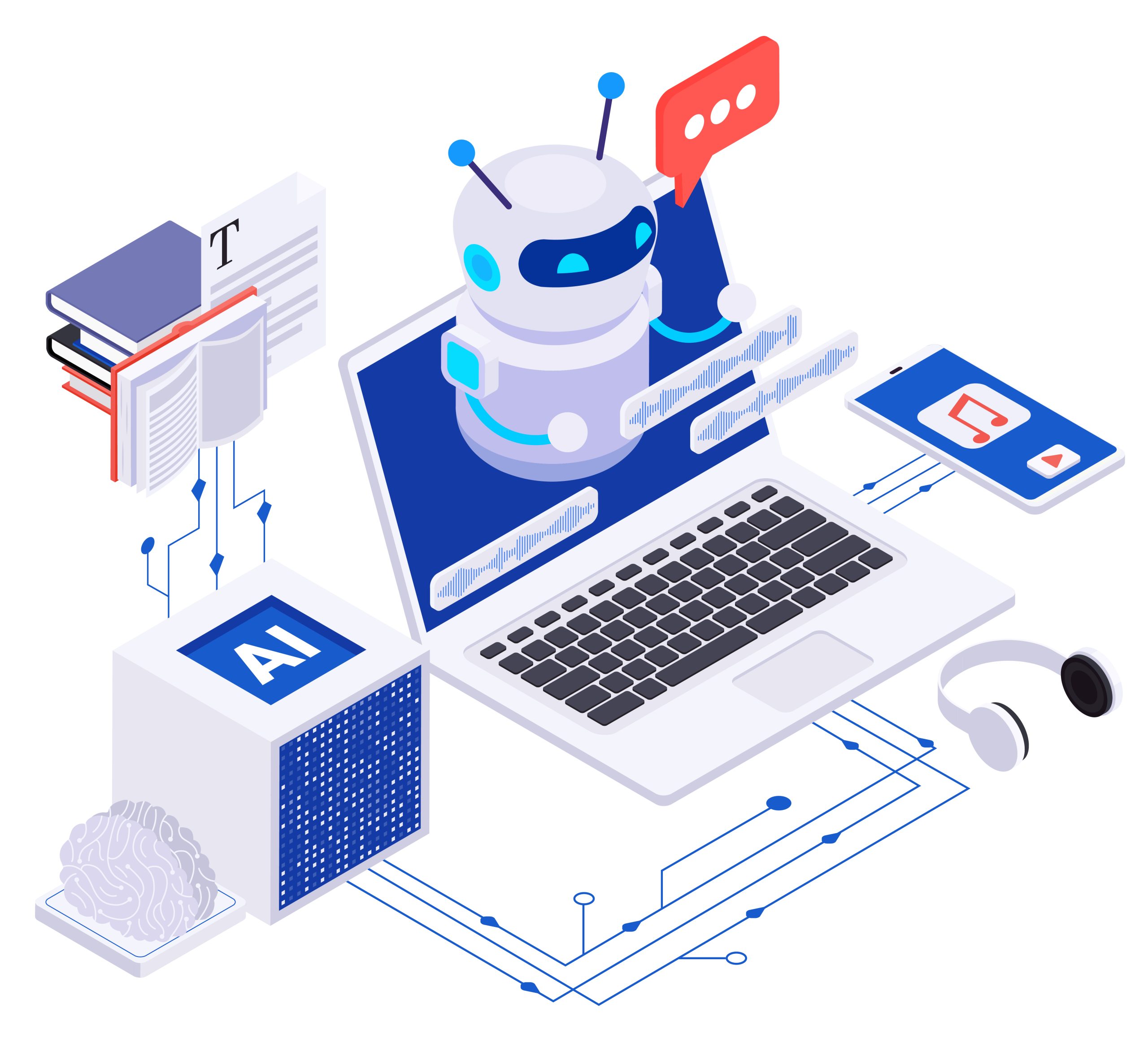 7.1 Top AI Platforms for PoC Development
7.1 Top AI Platforms for PoC Development